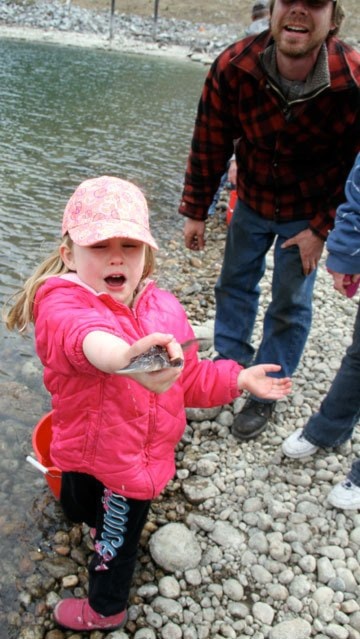Close to 1,000 people participated in releasing juvenile sturgeon along the Columbia River on Monday afternoon.
The Upper Columbia White Sturgeon Recovery Initiative started in 2000 and sturgeon have been released into the river for the past 10 years.
Approximately 25 to 30 per cent of all fish released survive the first six months, which are pretty good odds considering predators like the walleye also live in the river, said Traci Jensen, a fish culturalist.
“Juvenile sturgeon that survive are growing fast and making use of habitat throughout both the Canadian and U.S. sides of the border,” said James Crossman, white sturgeon co-ordinator with BC Hydro.
If the fish live past six months, Jensen said they’re fairly safe from then on, because over the next year their survival rate jumps to 80 per cent and then 90 per cent the year after that.
Sturgeon are the only fish that never stop growing, Jensen said. A full-size sturgeon can weigh anywhere from 200 to 300 pounds. They can also live for more than a century, although the oldest sturgeon currently found in the Columbia River are around the age of 60.
Jensen said having the sturgeon release each year is important to make the public more aware of the population.
The ones released this week were hatched 10 months ago at the Kootenay Trout Hatchery and kept there until this week. About 1,500 were released near the Hugh Keenleyside Dam in Castlegar, while an additional 500 were released in Beaver Creek near Trail.
“Seeing a whole bunch of generations being able to do this family activity is great,” Jensen said.
The sturgeon, although a little nervous at first, swam away quickly as soon as they were released.
“They’re going right to the bottom [of the river] where they’ll spend their life,” Jensen said.
The sturgeon release has been held annually along the upper Columbia River because the population of the fish has been dwindling. It is estimated that there are only 1,000 adult sturgeon between the Hugh Keenleyside Dam and the U.S. border. The current population hasn’t been reproducing for the past 30 years.
“During our sampling we have found the odd juvenile from natural reproduction in the river, but in essence there is no successful natural recruitment occurring,” Crossman said. “And we have a long wait to see if our hatchery-raised juveniles successfully reproduce one day — typically a female sturgeon will not reach reproductive maturity until 25 years of age.”
“We’ve been doing this for 10 years but we won’t know for another 15 years if they’re reproducing,” Jensen said.
The sturgeon release event for the public is supported by the Fish & Wildlife Compensation Program (FWCP), BC Hydro, Freshwater Fisheries Society of B.C., Teck, Golder Associates, Poisson Consulting, and Zellstoff Celgar Ltd.
